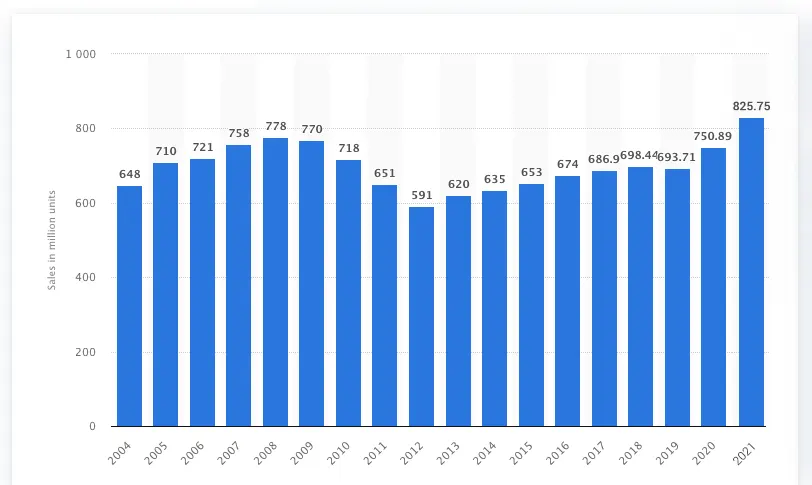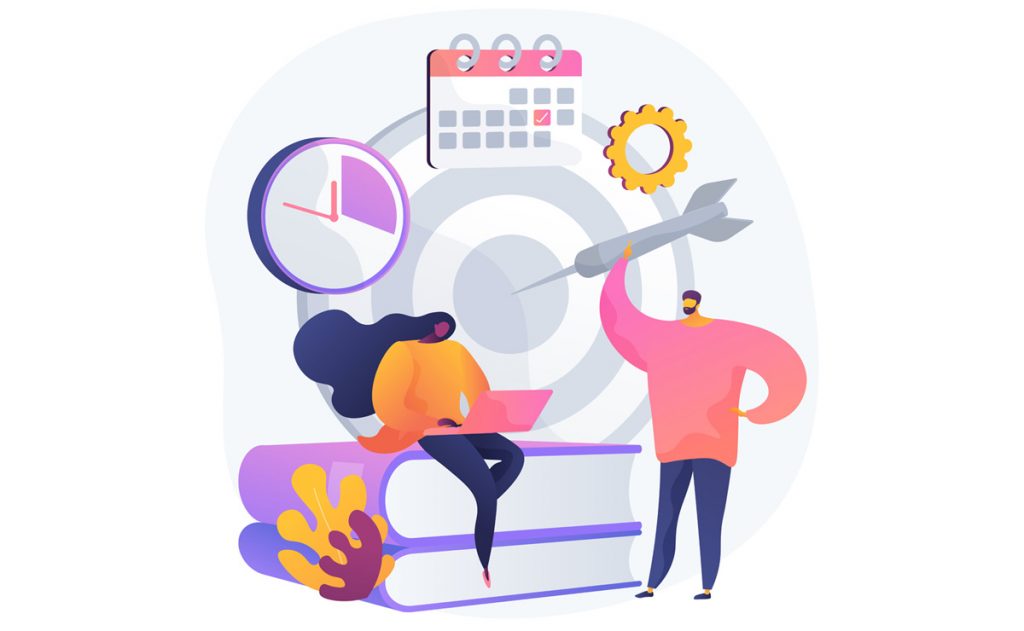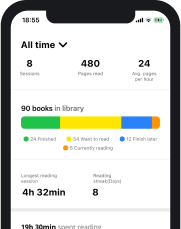Reading is a lot like going to the gym. Both of them thrive on commitment, discipline, and time. The book reading statistics below show one thing: just like going to the gym, reading is not for everyone. The similarities go even further: you may not have hours every day to read/go to the gym. But every little bit matters when it comes to training your body or your mind.
In this article, we have gathered a comprehensive list of statistics about reading books that we believe you must know in 2023 and beyond to help you discover some insightful and fun facts, as well as mind-boggling statistics and facts about reading and readers from all over the world.
Without further ado, let’s dive into some of the most interesting reading stats.
What Are the Most Interesting Statistics about Reading?
1. 35 percent of the world read more due to coronavirus
Lockdowns and movement restrictions due to the pandemic meant that most people remained indoors to curb the spread of the dreaded disease. This also meant that people needed to find things to keep them occupied in the house – a situation that also encouraged more people to take up reading in a bid to kill boredom.

Let’s hope everyone keeps up with their reading even after the whole crisis is over!
2. One of every three teenagers has not read a book for pleasure in a year
According to American Psychological Association, this can be largely attributed to the phenomenal rise of social media and gaming platforms that have significantly impacted the reading culture among millennials today.
A reading app like Basmo can help a lot in this area! Basmo gives digital natives the opportunity to treat reading like browsing the web. Teenagers are more familiar with mobile apps than books and Basmo bridges this gap.
Ready to take your reading game to the next level?
Try Basmo book tracker today!
Track your books, take notes, scan your favorite pages, and even gamify reading by comparing your progress with other readers and with reading statistics from all over the world. You can start feeling comfortable with reading again.
Want to give Basmo a try? It’s 1005 FREE, just like TikTok!
3. 23 percent of adult Americans didn’t read a book in 2020
Despite having one of the most advanced education systems in the world, a survey by Pew Research Center revealed that American adults with a high school diploma or less are far more likely to report not reading books in any format than their counterparts with a bachelor’s or advanced degree.
4. 825.75 million books were printed back in 2021
Even though digital penetration has somewhat affected traditional media like books and other non-digital formats, 2021 experienced a rather unusual rise in books printed in America. According to a report by Statista, this rise represented one of the highest surges since 2010 at 8.9 percent year-on-year.

5. People aged between 15 to 44 read for an average of 10 minutes or less per day
One of the most interesting books reading statistics we’ve uncovered is that this age group is more likely to watch more television than read a book, for instance. Throw in constantly catching on social media and time spent on reading reduces significantly.
On the other hand, 51-year-olds and above spend over 50 minutes reading. Couple this with the statistics on reading for teenagers above and you’ll see a trend. It’s not a good trend, but it’s there!
Source: BLS American Time Use Survey
6. Bill Gates reads 50 books a year
Reading is still the main way that I both learn new things and test my understanding.
Bill Gates
His love for reading is what has exposed the tech mogul to a world of opportunities.
Okay, you might not be able to match Gates’ record but this is a good motivation nonetheless. The trick is to start with smaller, achievable milestones – say about 10 to 15 books a year: that’s roughly one book a month – and work your way up.
By the way, you can check our list with the best books recommended by Bill Gates.
7. 88 percent of rich people “devote thirty minutes or more each day to self-education or self-improvement reading”
Successful people read a lot. Wealthy people have been known to develop daily habits such as exercising, yoga, a healthy sleeping routine, and reading.
Coincidence? We think not! Remember what we said above about how reading improves your cognitive functions?
If you are curious what are the books they prefer, check our list of top books successful people read.
8. Just six minutes of reading per day mean a lot for the development of young children
If you only retain one of these book reading statistics, make it this one: 6 minutes of additional reading time per day can significantly improve children’s reading performance.
That’s it! 6 minutes per day — everyone can find 6 minutes to spare, right?
9. Reading helps the elderly, too
Reading isn’t beneficial just for kids. A study published by Robert S. Wilson, PhD in 2013 has shown that reading can reduce mental decline in the elderly by 32 percent.
This is one good reason to grab a book, right?
10. You could read up to 55 books in a year
…if you took the time to speed up your reading. According to Lenstore, an average reader goes through 33 books in a year, while speed readers easily reach 55.
11. 30% of Americans read e-books instead of paperback
Research conducted by the Pew Research center has revealed that as of 2021 approximately 3 in 10 Americans have read e-books in the previous year. Even though paperback is still a clear favorite, the popularity of e-books is constantly rising from one year to the other.
12. 75 % of US citizens read at least a book in the last year
According to the same study, 3 in 4 Americans have read (at least partially) a book in the past 12 months, regardless of the format. Surprisingly, this figure seems to have remained unchanged since 2011.
13. Who doesn’t read at all in America?
Now that we know that 75% of Americans have read a book in the last 12 months, let’s have a look and find out who the other 25% are. According to the same study from Pew Research from 2021, the 25% of Americans who haven’t read at all in the past 12 months have a couple of things in common.
39% of the people with a lower level of education (high school diploma or less) reported not having read a book in the past year, while only 11% of those with higher education reported the same. The annual household income also seems to be correlated with the amount of reading done by the people in the household: people with incomes of 30,000$ or lower are a lot more likely to not read than those with earnings exceeding 75,000$ ( 31% vs 15%).

14. Women read (a lot) more than men
Research has shown that there is a substantial difference between the reading habits of men and women. Even though on a global scale, illiteracy seems to be more prevalent in women than in men, statistics are also showing that women who read, do it more often, and better than men. The difference is particularly huge when it comes to fiction, with women being responsible for 80% of the total sales of fiction books
15. The most reading is done in Asian countries
Recent statistics show that the countries where people spend the most time reading are Asian countries. India leads the pack with 10 hours 42 minutes per week spent reading by the average Indian, followed by Thailand with 9 hours and 24 minutes, and China with 8 hours on the dot. European countries are best represented by Sweden in the 8th spot out of 30, with an average of 6 hours and 54 minutes, while the USA sadly comes in on the 23rd spot with just 5 hours and 42 minutes.
How to become part of the solution with Basmo?
As you can see, reading statistics shed a bit of a grim light on the reading habits around the world. Despite the ever-growing number of books we have at our disposal, more formats available, and the means to purchase more books than ever, this amazingly healthy habit seems to be on a constant decline.
If you don’t want to be a contributor to these saddening statistics, using Basmo can seriously improve your reading habits, the amount of reading you will get done, and the overall quality of your reading sessions.
Here’s what Basmo can do for you:
Create reading lists with Basmo
In order to be able to read more, you will need to know what to read. Luckily, Basmo is a reading tracking app that comes with a series of additional features meant to take your reading to a different level.
Creating a reading list is a seamless activity, as it only takes a couple of seconds and a few taps. You can create several personalized lists, split into genres or however you see fit, and they can be easily customized and edited.
Having a reading list is essential for healthy reading habits, as it will help you spend less time thinking about what to read next after finishing a book.
Create a schedule and stick to it
Even though many of us still see reading as a simple pastime activity, the truth is that it’s a lot more than that. It can improve our health, our sleep, and will make us more empathetic and wise. Taking it seriously will improve our lives considerably, but in doing so, we need to start with a bit of structure. Having a reading schedule is an amazing way to ensure that you read enough.
With Basmo, you can create a completely personalizable schedule, selecting the exact days of the week and even different times for each day.
You can schedule your reading sessions in a way that doesn’t interfere with any of your other daily activities, and the app will even remind you of any upcoming reading sessions so you don’t forget about them.
Set goals
Knowing what you are working towards and visualizing your results is a great way of achieving your goals. Reading goals are obviously no different, and Basmo allows you to set personalized goals for your reading in a simple and effective way.
You can either set big-picture goals for the number of books you want to read in a year or micro-manage yourself with daily goals for the amount of time you spend reading.
The app will track your progress towards meeting your goals and you will be able to see interesting statistics about your reading in the app to know which aspects can be improved.
Conclusion
Familiarizing yourself with stats about reading is a great way of motivating you to read more and inspire you to improve your reading skills. Reading stats also broaden your perspective of the reading culture by understanding how it has evolved and the trends that have shaped it.
Do these statistics about reading books motivate you to get more serious about this habit? If not, we might help! Basmo makes reading fun and enjoyable for everyone!







